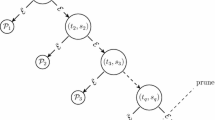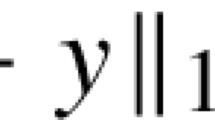Abstract
We consider a bilevel extension of the classical linear assignment problem motivated by network interdiction applications. Specifically, given a bipartite graph with two different (namely, the leader’s and the follower’s) edge costs, the follower solves a linear assignment problem maximizing his/her own profit, whereas the leader is allowed to affect the follower’s decisions by eliminating some of the vertices from the graph. The leader’s objective is to minimize the total cost given by the cost of the interdiction actions plus the cost of the assignments made by the follower. The considered problem is strongly \({ NP}\)-hard. First, we formulate this problem as a linear mixed integer program (MIP), which can be solved by commercial MIP solvers. More importantly, we also describe a greedy-based construction heuristic, which provides (under some mild conditions) an optimal solution for the case, where the leader’s and the follower’s edge costs are equal to one. Finally, we present the results of our computational experiments comparing the proposed heuristic against an MIP solver.
Similar content being viewed by others
References
Audet, C., Hansen, P., Jaumard, B., & Savard, G. (1997). Links between linear bilevel and mixed 0–1 programming problems. Journal of Optimization Theory and Applications, 93(2), 273–300.
Bard, J. F. (1998). Practical bilevel optimization. Dordrecht: Kluwer.
Beheshti, B., Özaltın, O. Y., Zare, M. H., & Prokopyev, O. A. (2015). Exact solution approach for a class of nonlinear bilevel knapsack problems. Journal of Global Optimization, 61(2), 291–310.
Beheshti, B., Prokopyev, O.A., & Pasiliao, E.L. (2015). Exact solution approach for the bilevel assignment problem. Computational Optimization and Applications, 2015. Accepted for publication.
Brown, G., Carlyle, M., Salmeron, J., & Wood, K. (2006). Defending critical infrastructure. Interfaces, 36, 530–544.
Burkard, R., Dell’Amico, M., & Martello, S. (2009). Assignment problems. Philadelphia: Society for Industrial Mathematics.
Colson, B., Marcotte, P., & Savard, G. (2007). An overview of bilevel optimization. Annals of Operations Research, 153(1), 235–256.
Dempe, S. (2002). Foundations of bilevel programming. Dordrecht: Kluwer.
Deng, X. (1998). Complexity issues in bilevel linear programming. In A. Migdalas, P. M. Pardalos, & P. Varbrand (Eds.), Multilevel optimization: Algorithms and applications (pp. 149–164). Dordrecht: Kluwer.
Feo, T. A., & Resende, M. G. C. (1995). Greedy randomized adaptive search procedures. Journal of global optimization, 6(2), 109–133.
Garey, M. R., & Johnson, D. S. (1979). Computers and intractability: A guide to the theory of NP-completeness. New York: W.H. Freeman.
Gassner, E., & Klinz, B. (2009). The computational complexity of bilevel assignment problems. 4OR, 7(4), 379–394.
Migdalas, A., Pardalos, P. M., & Värbrand, P. (1998). Multilevel optimization: Algorithms and applications. Norwell: Kluwer.
Nemhauser, G. L., & Wolsey, L. A. (1988). Integer and Combinatorial Optimization. NewYork, NY: Wiley.
Resende, M. G. C., & Ribeiro, C. C. (2011). Restart strategies for grasp with path-relinking heuristics. Optimization Letters, 5(3), 467–478.
Shen, S., Smith, J. C., & Goli, R. (2012). Exact interdiction models and algorithms for disconnecting networks via node deletions. Discrete Optimization, 9(3), 172–188.
Wood, K. R. (1993). Deterministic network interdiction. Mathematical and Computer Modelling, 17, 1–18.
Zenklusen, R. (2010). Matching interdiction. Discrete Applied Mathematics, 158(15), 1676–1690.
Acknowledgments
This material is based upon work supported by AFRL Mathematical Modeling and Optimization Institute. The research of the first three authors is also partially supported by grants from AFOSR. In addition, we are grateful to Dr. Behdad Beheshti for his helpful comments. Finally, the authors would like to thank anonymous referees whose constructive comments resulted in the improvements to this paper.
Author information
Authors and Affiliations
Corresponding author
Rights and permissions
About this article
Cite this article
Stozhkov, V., Boginski, V., Prokopyev, O.A. et al. A simple greedy heuristic for linear assignment interdiction. Ann Oper Res 249, 39–53 (2017). https://doi.org/10.1007/s10479-016-2118-3
Published:
Issue Date:
DOI: https://doi.org/10.1007/s10479-016-2118-3




